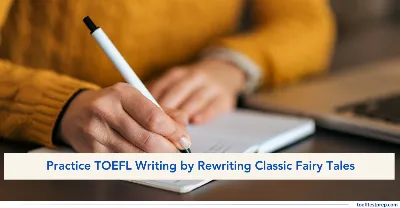Practice TOEFL iBT® Writing by Rewriting Classic Fairy Tales

"Rewriting classic fairy tales is a creative and effective way to prepare for the TOEFL Writing section. These familiar stories let you focus on improving grammar, tone, and sentence structure without the stress of coming up with new content."
Key Highlights
You’ve probably heard stories like Cinderella, Snow White, or The Three Little Pigs. But have you ever considered using them to practise your TOEFL Writing skills? These familiar tales offer clear plots and structure, allowing you to focus on improving grammar, vocabulary, and coherence. Rewriting them trains you to think critically about tone, sentence flow, and clarity—skills that are essential for the TOEFL. It’s a fun and low-pressure way to build confidence in your writing. Let’s explore how fairy tales can become a smart tool in your TOEFL preparation.
Why Use Fairy Tales for TOEFL Writing Practice?
Classic fairy tales are short, familiar, and packed with clear narrative structures. This makes them perfect for writing practice:
-
Familiar stories mean less time understanding the plot, more time on language skills.
-
Rewriting encourages paraphrasing, vocabulary expansion, and restructuring.
-
You practise different tones and audiences—from informal storytelling to academic summaries.
Rewriting is also less stressful than generating content from scratch. The core story is already there; your task is to elevate how it’s told.
|
Boost your writing score with clarity on how it's marked. |
Skills You’ll Build by Rewriting Fairy Tales
Each time you transform a fairy tale, you’ll sharpen several TOEFL Writing skills:
-
Paraphrasing: Essential for integrated writing tasks.
-
Cohesion and Coherence: Rewriting requires proper linking between sentences and ideas.
-
Grammar and Sentence Variety: Use compound, complex, and conditional structures.
-
Tone and Formality: Practice adjusting from casual to academic.
-
Vocabulary: Replace simple words with academic or descriptive alternatives.
In short, you’re strengthening both independent and integrated writing styles without the pressure of starting from a blank page.
|
Want to achieve your desired writing score on the TOEFL? |
Step-by-Step Guide: Using Fairy Tales to Practise TOEFL Writing
Here are the step-by-step instructions to use fairy tales for effective TOEFL Writing practice:
Step 1: Pick a Simple Story
Start with a short tale that you already know. Some great options:
-
Little Red Riding Hood
-
Hansel and Gretel
-
Goldilocks and the Three Bears
-
Jack and the Beanstalk
Choose one that’s short and easy to summarise so you can focus more on writing style.
Step 2: Rewrite the Story in a Formal, Academic Tone
Your first rewrite should aim to present the story as if it were a summary in an academic essay.
Example:
Instead of:
"Jack was poor and traded his cow for some magical beans."
Try:
"A young boy from a financially disadvantaged household exchanged livestock for what he believed were magical beans, reflecting both desperation and hope."
Tips for this version:
-
Use formal vocabulary.
-
Include cause-effect language ("as a result", "therefore").
-
Focus on clarity and structure.
Step 3: Try a Creative Rewrite with a New Point of View
Change the perspective of the story—for example, tell Cinderella’s story from the stepmother’s viewpoint or narrate Snow White as a news report.
This builds:
-
Creative expression (for independent writing)
-
Critical thinking
-
Tone control
Example:
"The prince claimed the slipper fit only one person. But no one asked how many women had identical shoe sizes. It was hardly scientific."
Step 4: Summarise the Moral or Theme in Essay Format
For more academic-style practice, turn the story into an opinion essay or reflective piece.
Prompt Example:
"What is the central lesson of The Three Little Pigs, and how is it relevant to modern society?"
Here you practise:
-
Structuring a clear thesis
-
Providing examples from the text
-
Using transition words and academic tone
This version prepares you for TOEFL Independent Writing Task 2.
Sample Rewrite Comparison
Here’s a quick comparison to show how a simple fairy tale sentence can be rewritten in a formal, TOEFL-ready style:
Basic:
"Goldilocks went into the bears’ house, tried their food and slept in their beds."
TOEFL Practice Version:
"An unsupervised young girl entered a private home and engaged in a series of intrusive actions, including consuming food and using furniture, which ultimately led to her confrontation with the returning residents."
Notice the shift in vocabulary, sentence complexity, and tone.
Weekly Practice Plan
Follow this weekly plan to build consistent TOEFL Writing skills using fairy tale rewrites:
| Day | Activity |
|---|---|
| Monday | Choose a new fairy tale and read the original version. |
| Tuesday | Rewrite it in a formal tone (150–200 words). |
| Wednesday | Change the point of view and rewrite the story creatively. |
| Thursday | Turn the story into an opinion essay (250–300 words). |
| Friday | Focus on editing—check grammar, sentence structure, and clarity. |
| Saturday | Share your version with a partner or tutor for feedback. |
| Sunday | Reflect and summarise what language or structure improvements you noticed. |
I hope this blog on practising TOEFL Writing through rewriting classic fairy tales gave you a fresh and effective tool for preparation. By working with stories you already know, you can focus more on grammar, tone, vocabulary, and structure—exactly what the TOEFL Writing section demands.
Additional Reads:
- How to Write High-Scoring TOEFL® Essays
- Types of Tasks in TOEFL Writing Section
- Common Mistakes in TOEFL Writing Section You Must Avoid
- Time Management Tips for TOEFL Writing Section
- Role of Full-Length Practice Tests in TOEFL Writing Preparation
- Is Scoring 30 in the Writing Section of TOEFL Doable?
Featured Articles

TOEFL Format Undergoing Significant Changes in January 2026
The TOEFL iBT format is changing in January 2026 with a smarter structure and easier scoring. Here’s everything you need to know to stay ahead.
August 06, 2025
Minimum TOEFL Score Requirement for South Korea Student Visa
Understand the TOEFL requirement for a South Korea student visa and English-taught programs, and prepare your application for success.
September 14, 2025
Minimum TOEFL Score for Study Visa in Poland
Understand TOEFL score requirements for securing a Poland student visa and joining top universities offering English-taught programs.
September 14, 2025
TOEFL Requirements for Animation & VFX Programs Abroad
Discover TOEFL score requirements for studying Animation and VFX abroad, and learn how to meet them for top creative universities.
September 14, 2025